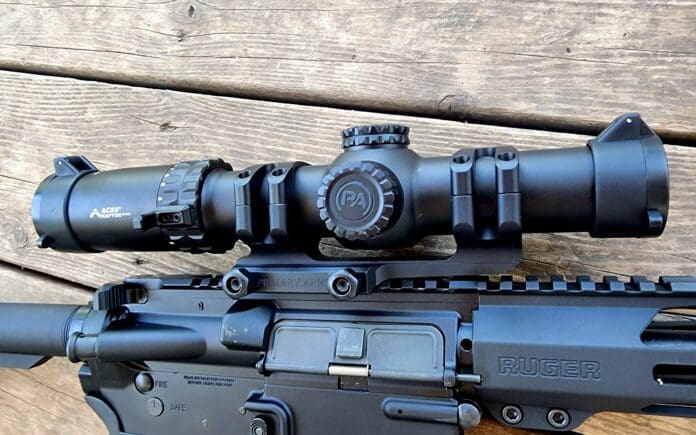
For the vast majority of real-world applications, it’s very hard to beat a low power variable optic (LPVO). Hunters have been shooting 1.5-4 or 1.5-6 power scopes for decades, with great effect. Primary Arms has raised the bar further by providing an inexpensive, durable LPVO with a 1-10X magnification range, the SLx 1-10X28 LPVO series.
No, the new Primary Arms SLx 1-10X28 LPVO doesn’t quite stand neck and neck with the newest Vortex Razor HD 1-10 LPVO, but it’s also roughly $3,000 less expensive. That price difference will be more than enough reason for a lot of shooters to go for the “good enough” LPVPO.
The most important aspect of any scope is the quality of the glass itself. The SLx may be designed in the US, but it’s made in China. It’s truly impressive to see how far Chinese budget optics have come just in the last few years. The edge-to-edge clarity and light transmission of this optic would have you believe it was made in Japan and costs a lot more than it does.
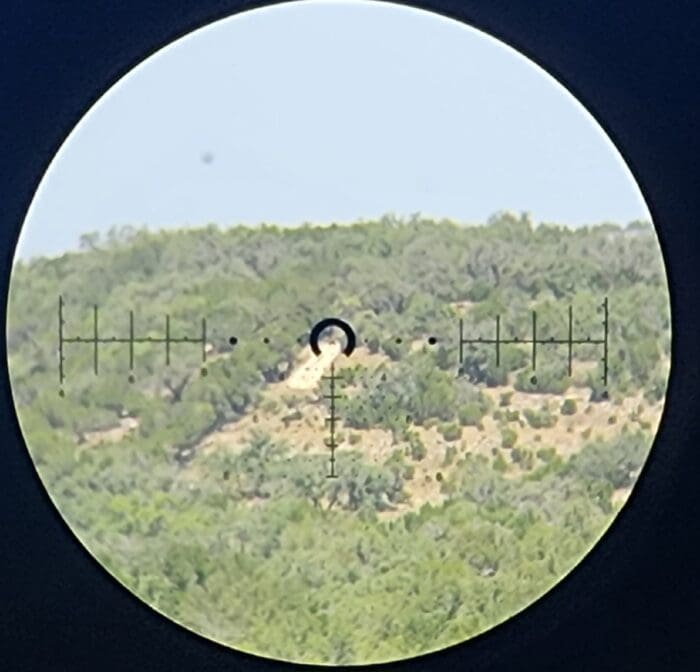
From 1 to 7 or 8 power, the image remains sharp. Above that…not so much. Take a look at the photo above. The dirt road in that photo is about 800 yards away with the scope at 10X. The glass is still nice and bright across the field of view, but the image is soft with additional distortion at the edges.
Ammunition for this and all TTAG reviews is sponsored by Ammo To Go. You can support TTAG by shopping at Ammo To Go for ammunition and more.
Now take a look at the photo below.
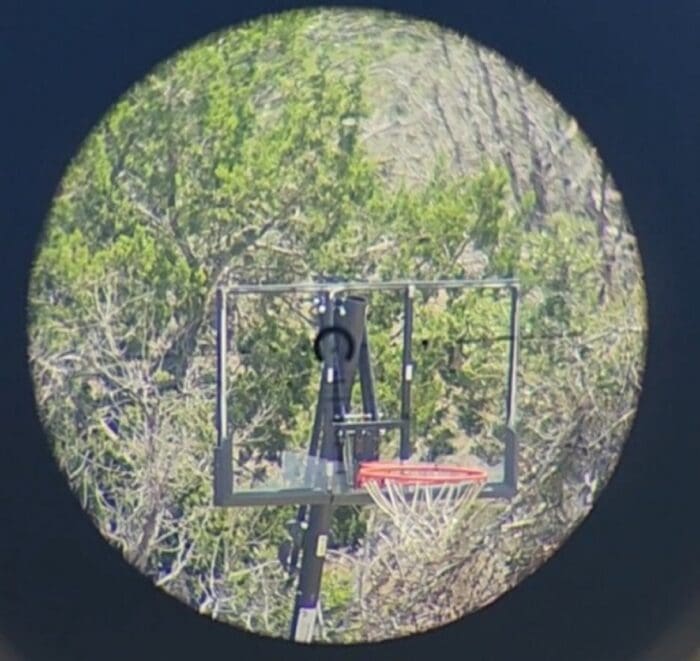
The old basketball hoop is 100 yards away, again at 10X. Even at this short distance, you can tell the image is starting to blur. Of course, this can be fixed with a diopter adjustment (there’s no parallax adjustment) which I’ve done a bit in this image to improve the clarity, but then, as you can see, the reticle itself begins to get blurry. There’s no winning in that situation.
I asked several people to verify that with their own eyes, and I also looked online to see if other users have noticed the same issue at 10X. Other users have noticed the same issue at 10X.
Not having a crisp image at maximum magnification is particularly challenging with this second focal plane scope, as that’s the only magnification where all of the stadia are correctly associated with their displayed numerical value. Depending on your target size, that might not matter. If you’re trying to hit a bright 19″ silhouette at 600 yards, you should be able to range that just fine. It’s when targets get smaller or not as clearly marked that things go awry.
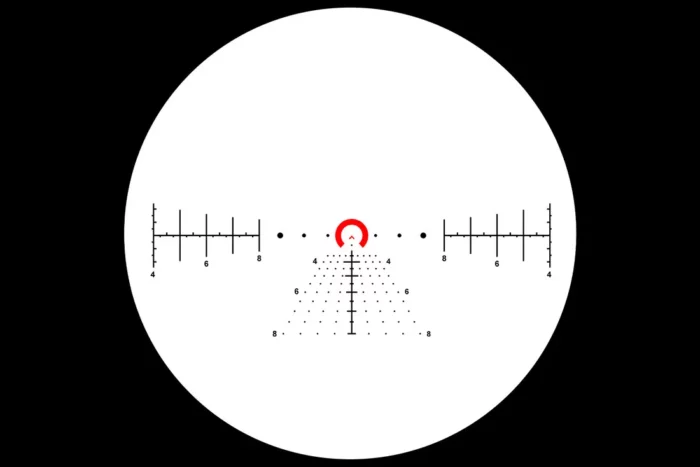
This version of the scope ships with the ACSS Raptor reticle, which is nothing short of genius. Like tens of thousands of servicemembers, I had a version of this reticle in my ACOG during my second tour in Afghanistan and absolutely loved it. It was one of the most significant advancements in small arms for the US soldier in 30 years.
For the shooter willing to dedicate themselves to fully understanding and memorizing the reticle, it’s a device that allows for rapid range finding, movement adjustment, and engagement on a target at short to moderate distances.
The only downside to the ACSS reticle is that, in order to gain its full effect, your round needs to fit some specific characteristics in terms of bullet shape, weight, and muzzle velocity. Those parameters, as well as a full description on the use of the reticle, can be found in the reticle’s user manual.
Unfortunately, the 16” barreled 7.62X51mm Ruger SFAR firing M118LR ammunition I used for most of this review doesn’t fit any of those parameters. There’s still a lot of value in the reticle, but there’d be a lot more if I was shooting a 20” gun and a 168gr SMK bullet.
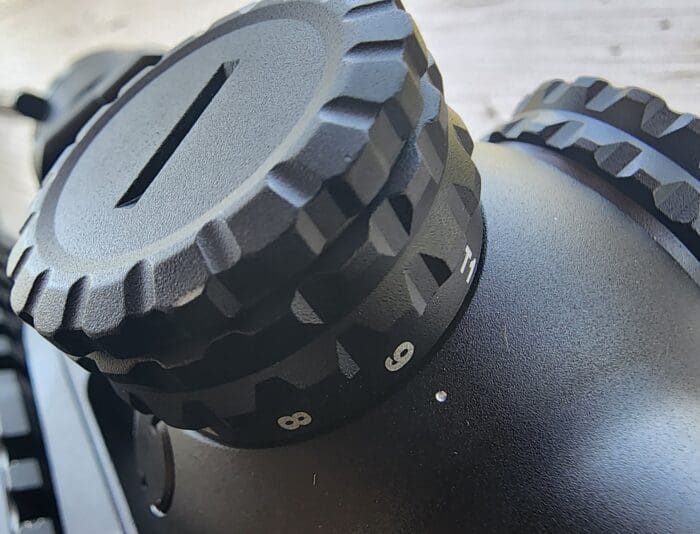
Like most of the Primary Arms optics, the SLx 1-10X28 features an illuminated reticle. There are 13 total settings, with 9 numbered plus 2 daytime bright settings and 2 night vision settings.
There’s no “off” setting between each “on” setting. Mounting an AN/PVS14 Monocular behind the lowest night vision setting, the center chevron and doughnut light up crisp and clear, but too bright. I could see the reticle just fine, just not the target. The reticle is visible even to the naked eye in a dim room, a sure sign it will be too bright to use in complete darkness with a night vision device.
The illuminated reticle is fed by a single CR2032 and the scope houses a spare inside the windage turret.
The SLx 1-10×28 ships with lens caps included, which is much appreciated. Unfortunately, the rear lens cap is too short and provides very little purchase on the scope, so it constantly falls off. If you want to use the provided rear lens cap you’ll need to set the diopter, then securely tape it down.
Primary Arms scopes are always feature rich. Beyond the ACSS Raptor illuminated reticle and the included turret caps, you’ll also find a removable quick throw lever on the magnification dial. I have to admit, I didn’t think I’d like these when they first came out, thinking it would get caught while moving through brush. Now I find myself looking for them on each scope I purchase.
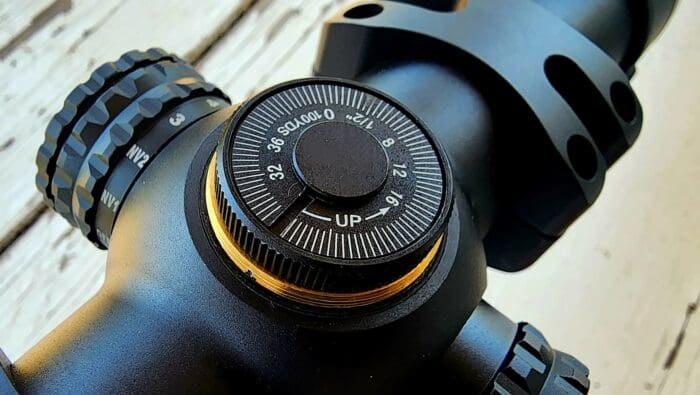
The SLx1-10X28 SFP is very much set up as a “set it and forget it” scope. The turrets are capped and there is no index mark on the body of the scope to line up your turret zero. Instead there’s a break in the turret ring where zero can be marked which will give you an idea of the turret position. As the turrets aren’t marked, you’ll have to count clicks when you need to move them, which is never a good idea. However, those clicks are fairly solid and easy to feel, so if, for some reason, you need to alter their position on the fly, you could carefully do so.
I tested the turrets a few ways, first by simply shooting a round, playing with the turrets a lot, running them to their extreme values and back, and then shooting another round. Both rounds were within the margin of error of the rifle system, shooter, and ammunition. I also did a tall target test out to 800 meters to see if the turrets tracked as they should. They do, within a 7% margin of error, which isn’t bad at all.
Note that the SLx 1-10×28 SLP features a 34mm main tube diameter. That’s not as common as the other (30mm) scopes in their line up, and not very long ago you’d have a hard time finding an inexpensive cantilever mount for it. Fortunately, Primary Arms has a series of these mounts available for pre-order which should ship in late August. Their higher end, Plx line of mounts is out now, but are significantly more expensive.
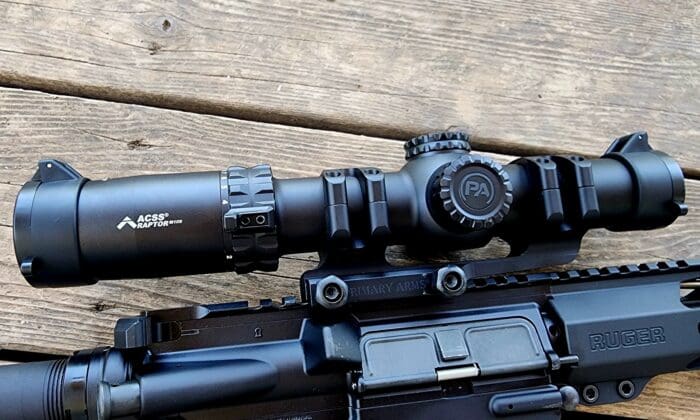
I soaked the scope in the tub for 30 minutes, then set it in the deep freeze for four hours. It dried fast in the 106 degree Texas heat in direct sun and showed no ill effects at all. I also mounted it and fired it on a variety of firearms, but mostly on the 16” Ruger SFAR. The turrets never failed to move unless I wanted them to and neither did the reticle.
The Primary Arms SLx 1-10×28 SFP comes with Primary Arms’ lifetime warranty. I’ve always found these folks to provide excellent customer service.
SPECIFICATIONS: Primary Arms SLx 1-10×28 SFP Rifle Scope
Click Value: .5 MOA
Eye Relief Low: 3.2 in / High: 3.5 in
Field View 100: Low: 110 ft / High: 10 ft
Focal Plane: Second Focal Plane
Illuminated: Partial
Length: 10.5 in.
Magnification: 1X – 10X
Night Vision Compatible: Yes
Reticle: ACSS Raptor M10S
Reticle Color: Red
Reticle Type: BDC
Total Elevation Adjustment: 40 MOA
Total Windage Adjustment: 40 MOA
Tube Diameter: 34mm
Weight: 19.1 oz.
Price: $449.99
Ratings (out of five stars):
Overall * * *
Primary Arms brings some great features to a very affordably-priced 1-10X power optic. Solid durability and clear glass are hallmarks of this entire line, and the always exceptional ACSS Raptor reticle is a big plus. The turret/return to zero setup isn’t ideal, though, and limits the optic. Points off for a fuzzy image at maximum magnification, especially on a second focal plane scope.


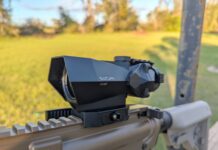

Pretty sure I don’t want to know what “rear-world applications” you would use a scope for!
Very first sentence:
“…rear-world applications…”
Should likely read “…[real]-world applications…”
Onward and upward.
Was corrected since I posted. Please delete my posts.
china…
Yeah, just read a report of Chinese malware being installed into US military computer systems.
I would buy the more $$ Japanese optics than anything made in China.
I do everything I can to buy America or avoid China made products.
It is not always easy.
I believe you can get Japanese optics from Primary Arms in some (if not all) of the GLx and PLx scopes. But those are significantly more expensive.
I like the extra hash marks and wind holds for the 50 yard increments. (350, 450, 550, etc.) They are noticeably absent on my 1-8 SLx FFP, which only has hashes for whole multiples of football fields. I guess they figured they could cram those in on a 10X scope. But I can range at any magnification, which is a big plus, so I’m pretty happy with mine.
The ACSS is indeed awesome. If I use a 50 yard zero (as recommended in the scope manual) with IMI RazorCore 77 grain, the hash marks line up nicely on a 70 degree day at my elevation. Highly recommended.
Almost forgot. I also like those vertical ranging bars, again which are not present on my scope, even though my scope is also tagged as an ACSS Raptor. Not sure why they did that, but I think they might have wanted to keep the 1x sight picture uncluttered. I dunno, just guessing.
My last pay check was $12000 working 12 hours a week online. my sisters friend has been averaging 15k for months now and she works about 20 hours a week. i can’t believe how easy it was once i tried it out. this is what i do. https://www.richepay.com/
Comments are closed.